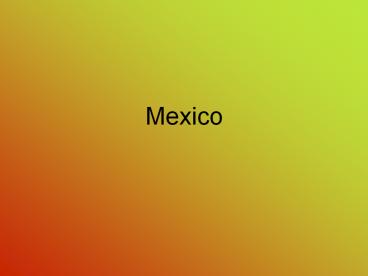Mexico - PowerPoint PPT Presentation
1 / 13
Title:
Mexico
Description:
d. hieroglyphics destroyed by Spanish priests. e. peaked before the arrival of Columbus ... creating economic opportunity, which will lessen migration to the U.S. ... – PowerPoint PPT presentation
Number of Views:19
Avg rating:3.0/5.0
Title: Mexico
1
Mexico
2
(No Transcript)
3
- History
- 1. Mayas
- a. Yucatan Peninsula
- b. developed systems of agriculture,
mathematics, engineering, highways, temples. - c. developed religion
- d. hieroglyphicsdestroyed by Spanish
priests - e. peaked before the arrival of Columbus
- 2. Aztecs
- a. came to prominence much later than the
Mayas - b. TenochtitlanMexico City
- --200,000 people. London was 1/5 this
size. - --stone roads
- c. Triple Alliancetrade and tribute
- d. Human sacrifices on Pyramid of the Sun.
20,000 to 50,000 per year.
4
- 3. Teotihuacan
- a. 30 miles from Mexico City. Largest
urban area - b. conquered by Aztecs in 1400s
- c. 2,000 apartment compounds
- 20 story pyramid of the sun
- Great Compound39-acre civic and
religious center - City grid based on stellar
constellations - d. as large as London by 500 A.D.
- 4. Incas
- a. Dominated Colombia to Chile at their
peak. - b. Linked by roads and suspension bridges.
- c. Machu Picchu
- d. Conquered by Pizarro in 1532.
- 5. European Conquest
- a. guns, technology, horses
- b. Conquistadorshit the shores in 1519.
5
- c. smallpox
- Spanish became active in the gold trade, which
attracted other Europeans. - e. Early civilizationsMaya, Aztec, Olmec,
Zapotec. - f. Milpagrew beans, squash, peppers, in same
plot. Bean plants climbed corn stalks while
squash and peppers grew between stalks. - 6. Colonial Period
- a. Haciendaslarge farmlands owned by
Spanish, used Indians for slave labor. Indians
also used as slaves in silver mines
6
- b. Influence of Catholic Church
- -towns grew around churches
- -plazaopen area in front of the church
used for community activities. - -Catholicism combined with native
religionour Lady of Guadalupe. Juan Diego - Indians attracted to Catholicism because of
sacrifice of Jesus, following priests. - c. cattle ranching, mining
7
- d. legacy rural poor, educated urban elite.
- 7. Mexican Independence1810 to 1821.
- a. September 1810. Miguel Hidalgo.
Western education. - Executed, but rebellion continued.
- b. Independence won in 1821.
- c. Series of dictators.
- 8. Loss of Texas
- a. thousands of Americans in Texas by
1830s, did not want to live under Mexican
government. - b. 1836the Alamo. 7 captured, including
Crockett, executed. 2,000 Mexicans vs. 200
Texans
8
- c. September 1836, Mexicans defeated, Santa Ana
captured, gave up Texas for his life. - d. Lost it for in 1848 after war with the U.S.
- e. other territories lost in 1830s and 1840s
southwestern U.S., Central America. - 9. Mexican Revolution 1910 to 1920
- a. kicked out a dictatorPorfirio Diaz
- b. war between regional leaders
- c. haciendas broken up, but farmers too
poor to work it. - d. drove out foreign business
- Modern Mexico
- 1. reopened to foreign business in 1990.
- 2. productive factoriesexpanded since NAFTA.
- 3. more urban
- 4. Tourism
9
- 5. Changes in daily life
- a. smaller families
- b. women working outside of the home
- c. increase in Protestant churches.
- d. Indians participating more in
government. - Mexicos Regions
- 1. Greater Mexico City
- a. ¼ of the population
- b. most of the GDP is produced here
- c. lack of jobs
- d. air pollution3 packs a day. Trapped by
the mountains
10
- 2. Central Mexico
- a. Guadalajara, second largest city.
- b. many fertile valleys
- c. attracting new factories
- 3. Gulf Lowlands and Southern Mexico
- a. prospering from natural gas and oil
deposits. - b. Veracruzan important port
- c. Southern Mexico is the poorest region
- -many are migrating
- -very traditionalsubsistence
agriculture - 4. Northern Mexico
- a. one of the most prosperousmodern
infrastructure. - b. Monterreyindustrial city. Other towns
have industrialized - rapidly.
- c. cattle ranching
- 5. 31 states and a federal district
11
- Challenges
- creating economic opportunity, which will lessen
migration to the U.S. - Takes away skilled workers.
- 2. reducing crime, particularly drug smuggling
- 3. Improving infrastructurepoor water supplies.
12
- Natural Environments
- 1. Mexican plateau takes up most of the country
- 2. Three mountain ranges Sierra Madre West
(Occidental), East (Oriental), South (del Sur). - 3. Valley of Mexico on southern end of the
plateau, location of - Mexico City.
- 4. Flattest part is Yucatan Peninsula
- Climate
- 1. varies by regiondeserts in north,
rainforests in the south - 2. Three factors that influence climate
- a. Pacific subtropical high pressure
celldeserts in the north. - b. Northeast trade windsblows in humid
air from Gulf of - Mexico.
- c. elevation
- -rain occurs where trade winds hit the
mountains - -makes the Mexican Plateau cooler
13
- 3. no major river
- Resources
- 1. minerals
- 2. petroleum from Gulf of Mexicomost important































